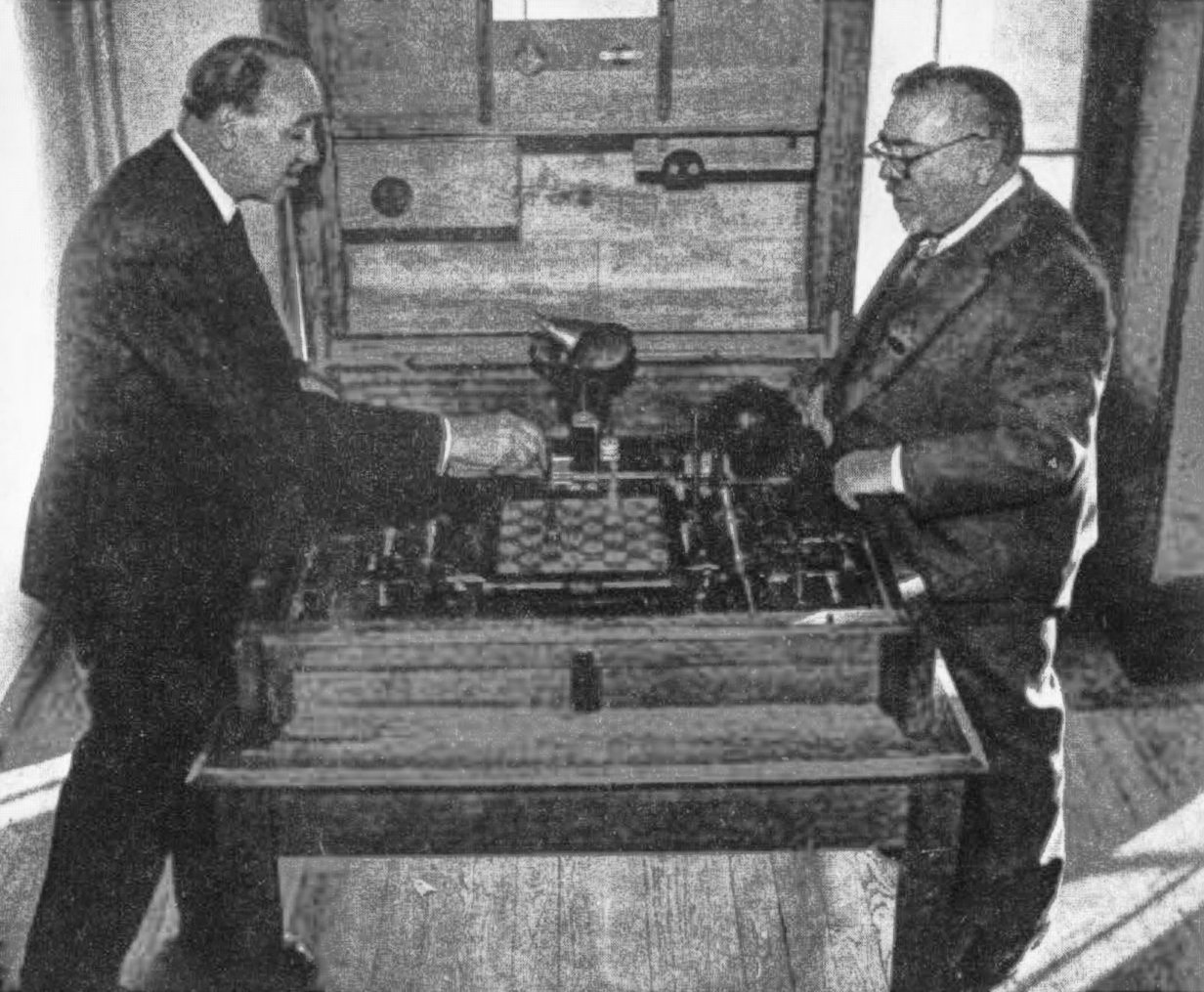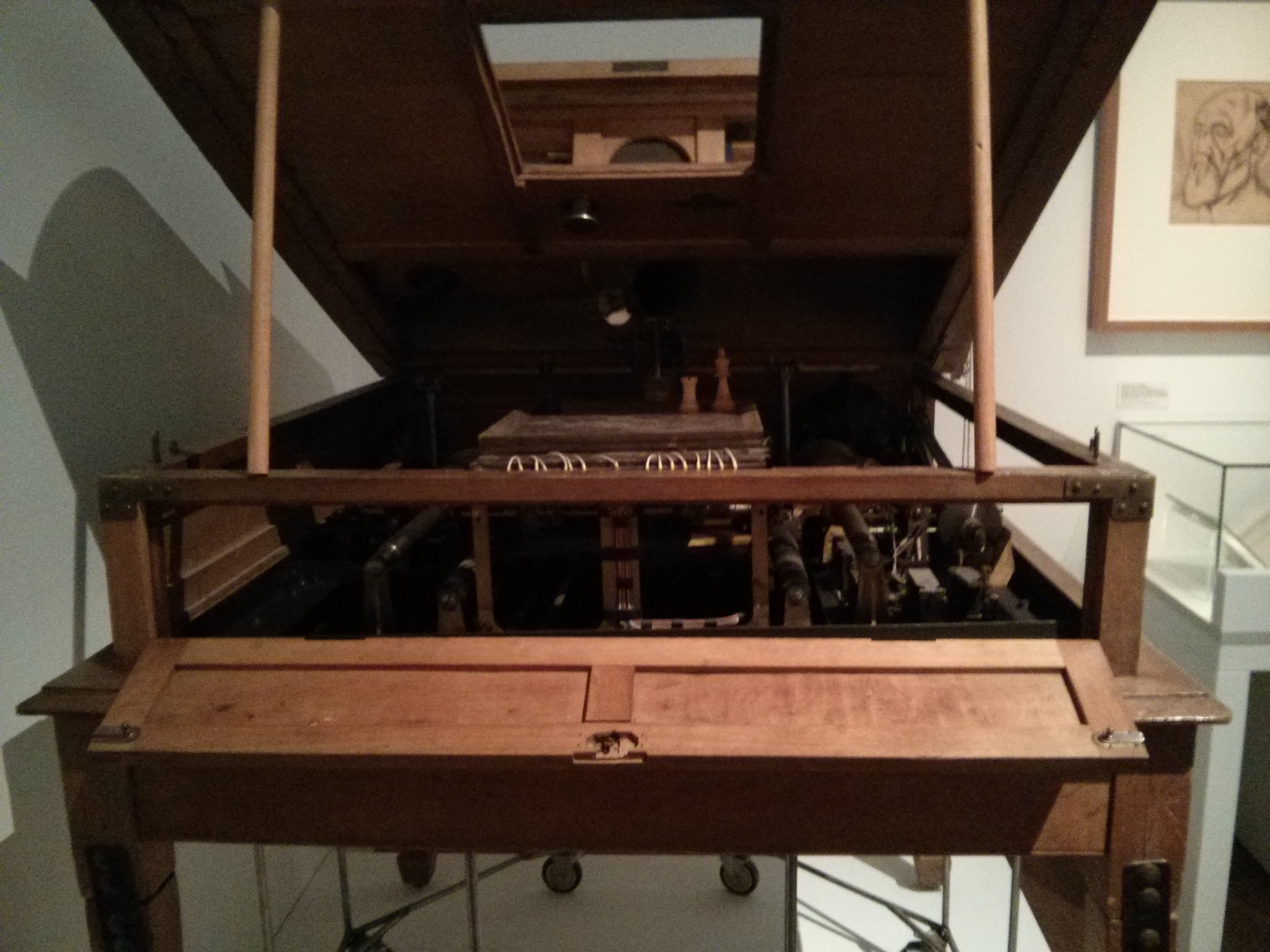El Ajedrecista on:
[Wikipedia]
[Google]
[Amazon]
 ''El Ajedrecista'' ( en, The Chess Player) is an
''El Ajedrecista'' ( en, The Chess Player) is an
 Both are still working and are on display at the ''Museo Torres Quevedo'' in the ''Escuela de Ingenieros de Caminos, Canales y Puertos'' in
Both are still working and are on display at the ''Museo Torres Quevedo'' in the ''Escuela de Ingenieros de Caminos, Canales y Puertos'' in
Automaton Chess by C. GilmoreChessbase News: Automatons
* King and Rook vs. King on
 ''El Ajedrecista'' ( en, The Chess Player) is an
''El Ajedrecista'' ( en, The Chess Player) is an automaton
An automaton (; plural: automata or automatons) is a relatively self-operating machine, or control mechanism designed to automatically follow a sequence of operations, or respond to predetermined instructions.Automaton – Definition and More ...
built in 1912 by Leonardo Torres y Quevedo
Leonardo Torres y Quevedo (; 28 December 1852 – 18 December 1936) was a Spanish civil engineer and mathematician of the late nineteenth and early twentieth centuries. Torres was a pioneer in the development of the radio control and automated ...
in Madrid
Madrid ( , ) is the capital and most populous city of Spain. The city has almost 3.4 million inhabitants and a Madrid metropolitan area, metropolitan area population of approximately 6.7 million. It is the Largest cities of the Europ ...
, one of the first autonomous machines capable of playing chess. As opposed to the human-operated The Turk and Ajeeb
Ajeeb was a chess-playing "automaton", created by Charles Hooper (a cabinet maker), first presented at the Royal Polytechnical Institute in 1868. A particularly intriguing piece of faux mechanical technology (while presented as entirely automat ...
, ''El Ajedrecista'' was a true automaton built to play chess without human guidance. It played an endgame
Endgame, Endgames, End Game, End Games, or similar variations may refer to:
Film
* ''The End of the Game'' (1919 film)
* ''The End of the Game'' (1975 film), short documentary U.S. film
* ''Endgame'' (1983 film), 1983 Italian post-apocalyptic f ...
with three chess pieces, automatically moving a white king
King is the title given to a male monarch in a variety of contexts. The female equivalent is queen, which title is also given to the consort of a king.
*In the context of prehistory, antiquity and contemporary indigenous peoples, the tit ...
and a rook
Rook (''Corvus frugilegus'') is a bird of the corvid family. Rook or rooks may also refer to:
Games
*Rook (chess), a piece in chess
*Rook (card game), a trick-taking card game
Military
* Sukhoi Su-25 or Rook, a close air support aircraft
* USS ...
to checkmate the black king moved by a human opponent.
The device could be considered the first computer game in history. It created great excitement when it made its debut, at the University of Paris in 1914. It was first widely mentioned in ''Scientific American
''Scientific American'', informally abbreviated ''SciAm'' or sometimes ''SA'', is an American popular science magazine. Many famous scientists, including Albert Einstein and Nikola Tesla, have contributed articles to it. In print since 1845, it ...
'' as "Torres and His Remarkable Automatic Devices" on November 6, 1915.
The automaton does not deliver checkmate in the minimum number of moves, nor always within the 50 moves allotted by the fifty-move rule
The fifty-move rule in chess states that a player can claim a draw if no has been made and no pawn has been moved in the last fifty moves (for this purpose a "move" consists of a player completing a turn followed by the opponent completing a tur ...
, because of the simple algorithm
In mathematics and computer science, an algorithm () is a finite sequence of rigorous instructions, typically used to solve a class of specific problems or to perform a computation. Algorithms are used as specifications for performing ...
that calculates the moves. It did, however, checkmate the opponent every time. If an illegal move was made by the opposite player, the automaton would signal it by turning on a light. If the opposing player made three illegal moves, the automaton would stop playing.
Technical description
Its internal construction was published by H. Vigneron.H. Vigneron: Robots. English Translation in: David Levy,Monty Newborn
Monroe "Monty" Newborn (born May 21, 1938), former chairman of the Computer Chess Committee of the Association for Computing Machinery, is a professor emeritus of computer science at McGill University in Montreal (formerly professor of electrical e ...
: ''Chess and Computers'', pp. 13-23. Computer Science Press, 1982. The pieces had a metallic mesh at their base, which closed an electric circuit that encoded their position in the board. When the black king was moved by hand, an algorithm calculated and performed the next best move for the white player.
Torres defined two zones for use in his algorithm, the first consisting of the a-, b-, and c- files, and the second consisting of the f-, g-, and h-files. The algorithm is as follows:
If the black King
* is in the same zone as the rook
** then the rook moves away from the zone to either the a- or the h-file.
* is not in the same zone as the rook and the vertical distance between the black king and the rook is
** more than a square
*** then the rook moves one square vertically towards the black king.
** one square, with the vertical distance between the two kings being
*** more than two squares
**** then the king moves one square vertically towards the black king.
*** two squares, with the number of squares representing their horizontal distance apart being
**** odd
***** then if the rook is on the a- or h-file, it moves to the b- or g-file respectively, and vice versa.
**** even
***** then the white king moves one square horizontally towards the black king.
**** zero
***** then the rook moves one square vertically towards the black king.
Here is an example game where White, following Torres' algorithm, checkmates the black King, who performs the best defense according to a chess endgame tablebase
An endgame tablebase is a computerized database that contains precalculated exhaustive analysis of chess endgame positions. It is typically used by a computer chess engine during play, or by a human or computer that is retrospectively analysin ...
, recorded in Portable Game Notation
Portable Game Notation (PGN) is a standard plain text format for recording chess games (both the moves and related data), which can be read by humans and is also supported by most chess software.
History
PGN was devised around 1993, by Steven J. ...
:EN "8/8/1k6/8/R7/8/5K2/8 w - - 0 1" 1. Rh4 Kc5 2. Kf3 Kd5 3. Ke3 Kd6 4. Rh5 Kc6 5. Ke4 Kd6 6. Rg5 Kc6 7. Kd4 Kd6 8. Rg6+ Kd7 9. Kd5 Ke7 10. Rh6 Kf7 11. Ra6 Ke7 12. Rb6 Kf7 13. Ke5 Ke7 14. Rb7+ Kd8 15. Ke6 Kc8 16. Rh7 Kb8 17. Rg7 Ka8 18. Kd6 Kb8 19. Kc6 Ka8 20. Kb6 Kb8 21. Rg8#In the first version, the pieces were plugged into the board, and the game states of check and checkmate were signaled with light bulbs. Leonardo's son Gonzalo made an improved chess automaton based on El Ajedrecista in 1920, which made its moves via
electromagnet
An electromagnet is a type of magnet in which the magnetic field is produced by an electric current. Electromagnets usually consist of wire wound into a coil. A current through the wire creates a magnetic field which is concentrated in ...
s located under the board. It also included a sound effect, with a voice recording announcing checkmate when the computer won the game.
 Both are still working and are on display at the ''Museo Torres Quevedo'' in the ''Escuela de Ingenieros de Caminos, Canales y Puertos'' in
Both are still working and are on display at the ''Museo Torres Quevedo'' in the ''Escuela de Ingenieros de Caminos, Canales y Puertos'' in Madrid
Madrid ( , ) is the capital and most populous city of Spain. The city has almost 3.4 million inhabitants and a Madrid metropolitan area, metropolitan area population of approximately 6.7 million. It is the Largest cities of the Europ ...
.
Notes
{{reflistExternal links
Automaton Chess by C. Gilmore
* King and Rook vs. King on
Wikibooks
Wikibooks (previously called ''Wikimedia Free Textbook Project'' and ''Wikimedia-Textbooks'') is a wiki-based Wikimedia project hosted by the Wikimedia Foundation for the creation of free content digital textbooks and annotated texts that an ...
History of chess
Chess automatons
1912 in chess
Spanish inventions
1910s robots